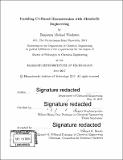Enabling Cl-Based bioconversion with metabolic engineering
Author(s)
Woolston, Benjamin Michael.
Download1196086586-MIT.pdf (33.36Mb)
Other Contributors
Massachusetts Institute of Technology. Department of Chemical Engineering.
Advisor
Gregory Stephanopoulos.
Terms of use
Metadata
Show full item recordAbstract
Single-carbon (C) substrates, such as synthesis gas and methanol, are attractive feedstocks for biochemical processes, as they are widely available, can be produced renewably, and do not compete with food supply. However, their use in industrial bioprocessing remains limited, primarily because microbes that utilize these substrates are poorly characterized biochemically, and limited tools exist for their genetic modification. This leaves the metabolic engineer with a choice: to develop genetic tools to enable engineering in the desired host, or to import the relevant catabolic pathway into a more tractable organism, such as Escherichia coli. This thesis explores both options within the context of developing strains for the conversion of C1 substrates into value-added chemicals and fuels. Clostridium ljungdahlii is an acetogen that grows autotrophically on synthesis gas (CO, H₂ , and CO₂) using the Wood-Ljungdahl pathway, and is a promising candidate for non-photosynthetic CO₂ fixation. In the first section, we extended its primitive genetic tools by developing a CRISPRi system for the targeted knockdown of specific genes. Constitutive downregulation of several genes with putative roles in energy conservation and carbon flux by up to 30-fold was demonstrated, and the associated phenotypes analyzed. Optimization of the promoter controlling dCas9 expression allowed for inducible knockdown, paving the way for dynamic metabolic control strategies to redirect carbon flux in engineered strains. To demonstrate this concept, several variants of a heterologous pathway for the biosynthesis of 3-hydroxybutyrate (3HB) were constructed, to probe 3HB production in the wild-type background and with various CRISPRi plasmids. The CRISPRi system represents a valuable contribution to the metabolic engineering field for its ability to redirect carbon flux, and is also useful to the microbiology community to probe gene function to answer open questions in the biochemistry underlying the Wood-Ljungdahl pathway. Efforts to develop genetic tools for the related acetogen Moorella thermoacetica are also described. To explore the alternative approach of importing a single-carbon catabolic pathway into a tractable host, in the second section E. coli was engineered to metabolize methanol. Screening various candidates of the three heterologous pathway enzymes enabled robust incorporation of 3 C-labeled methanol into central carbon metabolism. To further improve methanol assimilation, a kinetic-thermodynamic modeling framework was developed and combined with novel isotopic tracing experiments to probe potential pathway limitations. Flux leakage from the cyclical ribulose monophosphate (RuMP) pathway was identified as the primary bottleneck, as this led to the build-up of the toxic intermediate formaldehyde and ablation of the thermodynamic driving force for methanol oxidation. Strategies were developed to re-wire central metabolism accordingly, which restored the driving force and led to the identification of the kinetics of the first enzyme of the pathway - methanol dehydrogenase (MDH) - as the next limitation. These results represent the first systematic analysis of flux limitations in E. coli engineered for methanol metabolism, and provide clear targets for further metabolic engineering to enable synthetic methylotrophy. Finally, the development of a formaldehyde biosensor in support of evolutionary approaches to enhance MDH activity and partition carbon flux between formaldehyde assimilation and growth is described.
Description
Thesis: Ph. D., Massachusetts Institute of Technology, Department of Chemical Engineering, May, 2017 Cataloged from the official PDF of thesis. Includes bibliographical references (pages 235-261).
Date issued
2017Department
Massachusetts Institute of Technology. Department of Chemical EngineeringPublisher
Massachusetts Institute of Technology
Keywords
Chemical Engineering.